The balancing act of Østre Landsret

Courts are public spaces with deeply private functions - how do you balance such contrasting intentions? At Østre Landsret, it is an act of architectural negotiation, signified in everything from window design to spatial layout.
The courts may belong to the people, but architecturally they’re rarely the open and active public spaces that libraries, plazas, or even city halls are known to be. More often than not, a visit corresponds to a major life event and requires privacy, security, and solemnity.
Østre Landsret, (Eastern High Court), currently under construction in Copenhagen’s Nordhavn district, is designed to accommodate the entirety of this complex cocktail. It is both open and secure, structured and versatile, fundamental and complex, layering the flows of users without requiring them to overlap.
The upper floors are dedicated to the court staff, flexibly laid out to allow them to adapt their specific functions as needed. The lower floors are reserved for the court records and the users of the house – in short, the public. Vertical connections (stairs or elevators) are discreetly tucked away, accessible to staff without being immediately visible to the general public. The interior functions of the house are reflected in the exterior of the building, where windows appear almost carved into the deep mass of the facades, subtly signifying a division between the functions of the public and professional /private levels.
Diagrammatically, it’s simple. Private functions are kept above and below the ground level, connected discreetly and, more essentially, privately. Defendants are brought up into the courts where prosecutors must descend a floor to reach them, separated by a public floor in which all parties meet.
At the ground level, a café extends along the entire facade to Istanbul Street, where it opens up to expose dining and work spaces along the facade. The dialogue between street and interior is as clear as the glass that separates them.
Both spatially and materially, the building creates an environment of professionalism, where society's laws and the expression of power are combined with the security, sobriety, and the overwhelming emotion that users may experience as they interact with the law.
Construction on the project is currently underway, and the project is expected to reach completion in 2021. The new Eastern High Court is designed in close collaboration with A. Enggaard and Norconsult.



